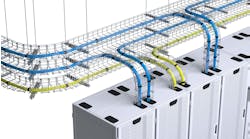DCIM Software: Creating a Single Version of Truth
In this week’s Voices of the Industry, Herman Chan, President of Sunbird Software, discusses the data challenges facing modern data center managers and how DCIM software can dramatically reduce data center management complexity by enabling seamless integration with existing data stores.
Herman Chan, President of Sunbird Software
Data center managers continue to struggle with the complex, distributed operations of modern data center environments. Separate teams own distinct aspects of the data center and manage them using their own systems, including BMSs, CMDBs, and Data Center Infrastructure Management (DCIM) software. As a result, organizations often end up maintaining multiple, disparate systems for different areas of the data center.
However, having so many separate systems for data center management creates a number of challenges, including inaccuracies across data stores, reduced productivity due to manually replicating data, and the inability to fully view and analyze all available data. In fact, according to IDC’s Datacenter Capabilities and DX Survey (2018), having management systems for each aspect of the data center was among the top challenges facing respondents.
To better leverage data across the enterprise, break down organizational silos, and gain the ability to provision IT resources with the speed and responsiveness of a cloud provider, more organizations are looking for ways to integrate their data center software solutions to create a single version of the truth. However, integration is often easier said than done.
Common Barriers to Data Center Software Integration
In their attempts to integrate different data center software, many organizations run into issues that cannot be easily solved:
- Available tools do not fit the business reality. Most tools lack the flexibility to match an organization’s business logic and processes exactly. For example, some vendors use default fields that won’t map to the data an organization captures and uses on a regular basis, so teams may not be able to track the right data. In other cases, the systems may be closed or only push data in one direction. As a result, organizations need to change their use cases to fit the data center software.
- Making integration work requires too much time and effort. The technical side of integration does not always go smoothly. The data may not sync properly, the implementation team could miss a critical step, derailing the entire project, or performance may be poor.
- Opportunities to leverage data are limited. Even if integration is successful, it may be too difficult to create a single, usable version of the truth. Software limitations, lack of time, and inadequate knowledge of data analysis techniques can hinder teams from fully leveraging the data across multiple systems. At the same time, you may not want certain systems to be fully integrated due to technical or security constraints, but you may still want to be able to view or export their data.
- Teams are siloed and do not understand the value of integration. Different teams tend to focus on only their respective areas of the data center, missing valuable opportunities to reduce manual effort by having data automatically populated, manage to shared KPIs, and drive a culture of data collaboration. Teams need to understand the use cases and value of correlated data, but this cannot happen when teams are siloed.
Although connecting different data center software is a good starting point, what organizations really need is a way to easily combine and correlate data across multiple systems to create a holistic, vertically integrated view of data center operations. To achieve this vision, the goal should not be to maintain only one system or to have only one gatekeeper for data center management. Rather, the better way forward should be for modern data centers to standardize on a set of tools that are easy to use, work with what you have, and make it simple to view and update the same datasets – no matter which system you are using.
DCIM software is often the missing piece for solving your integration puzzle.
DCIM Software: A Key Piece of Your Integration Puzzle
How can organizations enable integrations that not only work seamlessly but also allow them to leverage data across the enterprise? That’s where DCIM software comes in.
Second-generation DCIM software provides the capabilities needed to counter the integration challenges of modern data center management:
- Customizations to fit your business logic. Instead of being stuck with a “one-size-fits-all” approach, DCIM software can be customized to fit your existing business processes. For example, in addition to the most common out-of-the-box fields for capturing asset data, DCIM software enables users to create their own fields and to place these fields in the layout that makes the most sense for them.
- User-configurable connectors and open APIs. Second-generation DCIM software makes it easy to ensure that your integration works from the start. Unlike closed systems and those with APIs that do not support full integration, DCIM software supports open APIs and connectors that work with the systems you already use for data center management to automatically replicate data, decreasing manual effort, improving data accuracy, and providing more flexibility for integration that fits modern data center environments.
- Built-in, zero-configuration data center business intelligence and analytics. Having the data automatically pushed across systems is helpful, but the actionable insights you glean from that information are what’s truly important. Such insights can be hard to come by, however, if you need to spend hours manually analyzing the data. DCIM software provides dashboards and reports built around your most common use cases so you can immediately identify your key metrics and begin to get value from your data. Alternatively, you can easily export the data for additional analysis.
- Ability to personalize and share customized data views. Breaking down organizational silos to leverage data across functional teams is a key benefit of integrating your disparate data stores. DCIM software supports data collaboration efforts by allowing users to personalize their dashboard views with the data that matters most to them, and to then share these views securely with management, other members of their own teams, and even other departments, such as finance or customer service.
The success of your integration isn’t isolated to whether the different systems can “talk” to each other. Whether the integration can help you take advantage of data to make smarter, more informed decisions is just as important. A comprehensive DCIM solution can help you meet both needs.
Bringing It All Together
As modern data center environments become more complex and difficult to manage, organizations must learn to better leverage their data to make smarter data center management decisions, or risk being unable to provision IT resources with the agility that customers have come to expect. Integrating disparate data stores seems like a step in the right direction, but it can be fraught with challenges and ultimately not address critical business processes or technical requirements.
DCIM software is often the missing piece for solving your integration puzzle. Through automation, integration, and compatibility with the devices and systems you already use, DCIM software can enable you to address the challenges of modern data center management, break down organizational silos, and most importantly, maximize the value of your data to better serve your customers.
Herman Chan is President of Sunbird Software.





